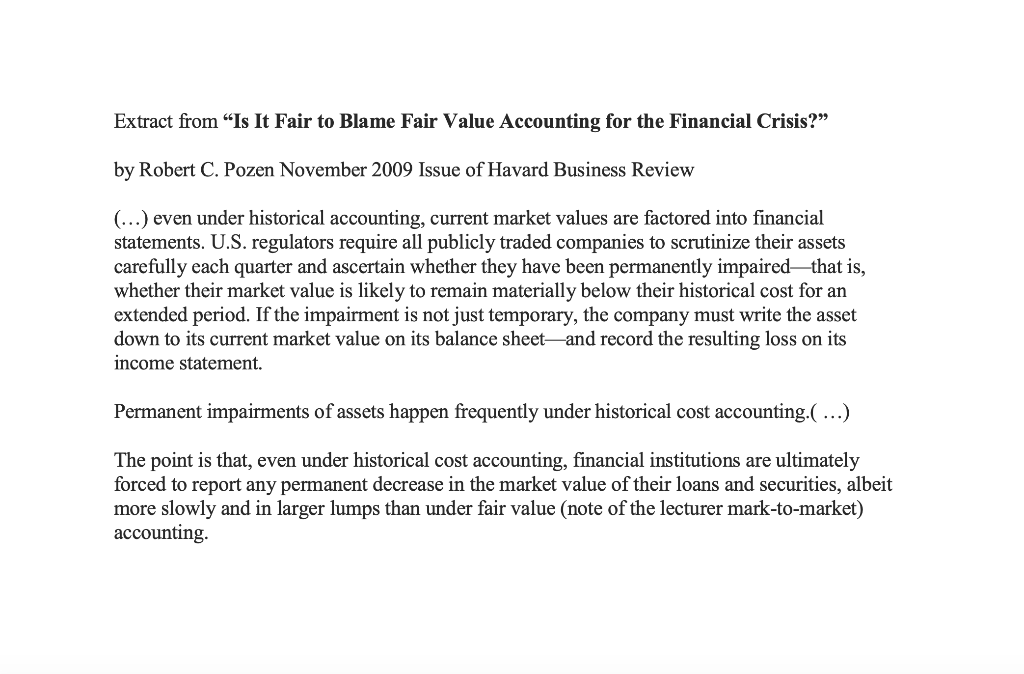Question
QUESTION 26 Answer BOTH questions. a) Short selling is an investment or trading strategy that speculates on the decline in a stock or other securities
QUESTION 26
Answer BOTH questions.
a) Short selling is an investment or trading strategy that speculates on the decline in a stock or other securities price (Investopedia).
Using exclusively the material of this course, show how this statement contradicts the definition provided by the law and regulation and ignores other uses of short selling. Provide illustrations and examples to support your analysis.
(4 marks)
b) Read the extract from an article in the Harvard Business Review provided here:

Explain why the impairment requirement described in this article (that we have not covered in class) makes held-to-maturity securities closer to trading securities than generally thought. identify and illustrate with an example the difference(s) that remain between the two types of securities, even when the impairment requirement is met.
(4 marks)
Write your answers on a new sheet of paper preferably without lines; write your full name and student number at the top of the sheet; scan or take a photo; convert into pdf and upload one pdf file on the link below (meaning you need to merge different pictures into one file if you have several). Keep the sheet with your answers for future reference.
Extract from "Is It Fair to Blame Fair Value Accounting for the Financial Crisis? by Robert C. Pozen November 2009 Issue of Havard Business Review (...) even under historical accounting, current market values are factored into financial statements. U.S. regulators require all publicly traded companies to scrutinize their assets carefully each quarter and ascertain whether they have been permanently impairedthat is, whether their market value is likely to remain materially below their historical cost for an extended period. If the impairment is not just temporary, the company must write the asset down to its current market value on its balance sheetand record the resulting loss on its income statement. Permanent impairments of assets happen frequently under historical cost accounting(...) The point is that, even under historical cost accounting, financial institutions are ultimately forced to report any permanent decrease in the market value of their loans and securities, albeit more slowly and in larger lumps than under fair value (note of the lecturer mark-to-market) accounting. Extract from "Is It Fair to Blame Fair Value Accounting for the Financial Crisis? by Robert C. Pozen November 2009 Issue of Havard Business Review (...) even under historical accounting, current market values are factored into financial statements. U.S. regulators require all publicly traded companies to scrutinize their assets carefully each quarter and ascertain whether they have been permanently impairedthat is, whether their market value is likely to remain materially below their historical cost for an extended period. If the impairment is not just temporary, the company must write the asset down to its current market value on its balance sheetand record the resulting loss on its income statement. Permanent impairments of assets happen frequently under historical cost accounting(...) The point is that, even under historical cost accounting, financial institutions are ultimately forced to report any permanent decrease in the market value of their loans and securities, albeit more slowly and in larger lumps than under fair value (note of the lecturer mark-to-market) accountingStep by Step Solution
There are 3 Steps involved in it
Step: 1

Get Instant Access to Expert-Tailored Solutions
See step-by-step solutions with expert insights and AI powered tools for academic success
Step: 2

Step: 3

Ace Your Homework with AI
Get the answers you need in no time with our AI-driven, step-by-step assistance
Get Started


